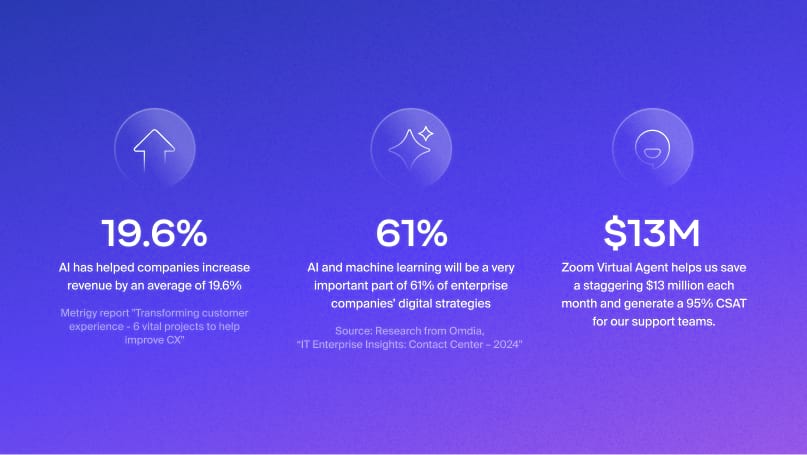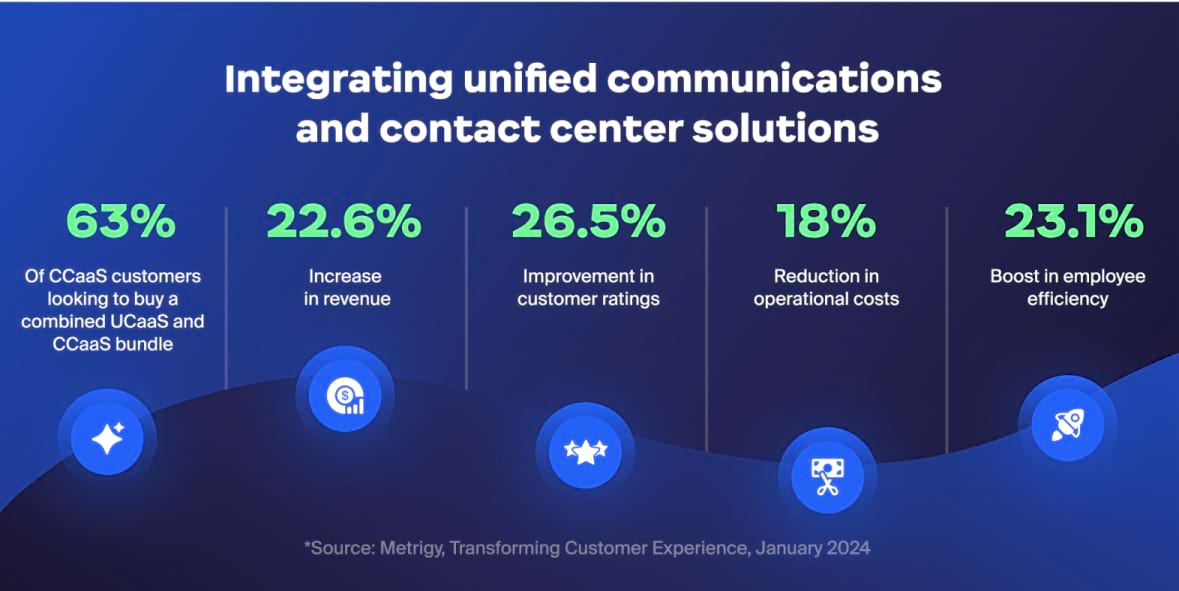Are you trying to find the right balance between AI and human interaction in the contact center? In this essential practical guide, we break down all the benefits of AI and share some steps to help you develop an AI-powered contact center that amplifies the human touch your customers crave.
Getting started with contact center AI
- 01 Customer experience AI: Why it’s here to stay - Jumplink to Customer experience AI: Why it’s here to stay
- 02 Into the unknown: Common AI challenges - Jumplink to Into the unknown: Common AI challenges
- 03 How will contact center AI help my organization? - Jumplink to How will contact center AI help my organization?
- 04 Five steps to contact center AI greatness - Jumplink to Five steps to contact center AI greatness
No matter which way we turn, we’re all hearing about AI. Generative AI (GenAI), Agentic AI, they’ve been buzzwords in meeting rooms, at kitchen tables, and on social networks across the globe. And there’s serious substance to the hype. According to a recent McKinsey report, GenAI could add up to $23 trillion dollars annually to the global economy. Gartner® predicts “By 2028, 33% of enterprise software applications will include agentic AI, up from less than 1% in 2024, enabling 15% of day-to-day work decisions to be made autonomously.”*
If you haven’t already considered how to implement AI, there’s a chance you’ll fall behind your competitors, not to mention having to answer to your executive team and board members.
When it comes to the contact center, AI has quickly become a dominating theme and will no doubt lay the groundwork for the next-generation contact center. Gartner predicts that agentic AI will resolve 80 percent of common customer service issues without intervention by 2029. With customer expectations on the rise, AI can help create efficiencies and empower agents to provide the kind of care customers demand now and in the future. In fact, Metrigy’s recent report, Transforming customer experience - 6 vital projects to help improve CX, found that when companies use AI for customer engagement, they increase revenue by an average of 19.6% and improve customer ratings by 20.5%.
We’ve seen these results first hand at Zoom, where our intelligent virtual agent helps us save millions each month and generate a 97% self-service rate and a 28% increase in CSAT.

It isn’t about automating everything so your customers never deal with a human. It’s about enabling human connection, providing the personal touch your customers crave that can create a lasting impression.
When preparing your contact center AI strategy, it’s important to remember this:
- It’s about leaving your customers with that warm fuzzy feeling they can only get after a seamless and satisfying customer experience.
- It’s about helping your agents feel more empowered and focused, giving them time back to deal with complex queries more effectively.
As Metrigy points out in their 2024 report, Use AI to enhance - not eliminate - the human touch, in the past year, 73% of consumers have had less than two out of five customer experience issues resolved without human involvement.
But with so much information about AI, figuring out where to start implementing it in your organization can be a minefield. When dealing with customers, it’s essential to tread carefully and avoid jumping on the AI hype wagon without a plan.
In this essential practical guide, we break down all the benefits AI can bring to your contact center and share some steps you can take now to start developing an AI-first contact center that amplifies the human touch your customers crave.
No doubt you’re facing one or all of the challenges below. You’re not alone! Let’s look at the most common obstacles when considering how to effectively get AI off the ground in the contact center.
Hard-to-predict ROI
Predicting return on investment (ROI) can feel like trying to hit a moving target. But by taking a thoughtful, step-by-step approach (as we’ve laid out in this guide), you’ll see where AI can make the end goals of higher customer satisfaction and increased agent productivity and engagement much easier to reach.
Cost implications
We get it; investing in AI can feel like a hefty check to write. But don’t let the dollar signs scare you away. With the right strategy, AI can actually be a budget-friendly addition to your contact center arsenal. For instance, you can start saving almost instantly by deploying an intelligent virtual agent as a support alternative to facilitate easier self-service. As mentioned earlier, after Zoom deployed Zoom Virtual Agent for customer support we saved millions in operational costs by moving 97% of queries to self-service.
AI can also shorten handle times for customers who do require an agent thanks to automatically generated customer summaries that give the agent context at a glance and reduce the need for customer repetition.
Training, adoption, and roll-out
In many cases, low-code or no-code technology (including GenAI) has made it much easier to develop and implement AI-driven capabilities across the contact center. But one of the biggest stumbling blocks in AI implementation is getting your team up to speed. When you introduce AI, your agents’ day-to-day lives will likely change. But with that change comes an opportunity to uplevel their skill set and grow in their roles. First, foster a culture of trust by addressing any concerns they may have. Second, give them the resources they need to elevate their skills. And when it comes to training sessions and hands-on support, the right innovation partner can make the AI rollout a smooth ride for everyone involved.
Lack of a plan
“Fail to plan: plan to fail,” as they say. This couldn’t be truer when thinking about how to implement AI in your contact center. Without a clear vision, you might find yourself wandering aimlessly in the digital wilderness. With a solid plan, you can ensure your AI implementation is smooth sailing.
Data privacy concerns
Of course, the safety and security of customer and company data is beyond critical. In a sea of new and untested models and vendors, how can you be confident that the one you pick is a trusted organization? It’s important to understand how a vendor will use your data for training their AI models or how they share data with third-party AI models. Choosing a responsible vendor is perhaps the most significant decision you’ll make.
Lack of knowledge
When it comes to AI, do you feel like you’re diving into the pool’s deep end without your water wings? Fear not! One of the biggest hurdles in implementing AI in your contact center is simply not knowing where to start. But hold on tight; we hope this guide will set you on your way, and if you need more information, we can partner with you to make it an even easier ride.
The How-to of CX AI: 5 actionable steps for leading AI adoption and upskilling in your business.

You’ve undoubtedly heard the news — AI can help your contact center business — a lot! But how? As Forrester outlines in their trends report, Generative AI is The Catalyst For Change in The Contact Center, the rush to adopt GenAI in the contact center has highlighted significant gaps stemming from a historical underinvestment in technological underpinnings and operational processes. This drive for innovation has finally given enterprises a compelling reason to confront existing shortcomings and prioritize investments in long-neglected areas.
Let’s start with your most important asset: your agents. Then, we’ll explore how AI can help your customers and your business as a whole.
1. How AI helps your agents
AI can help your agents do their jobs better in a couple of simple but effective ways, empowering them to serve customers faster and more effectively. But more than that, they get time back to do more meaningful work, spend more time with customers on complex queries, and add more value to their interactions. Let’s dive deeper.
AI reduces frustration and attrition
Repetitive tasks create high rates of contact center agent attrition. As Juanita Coley, CEO of Solid Rock Consulting, notes:
Contact center agent turnover is 30-40%. When AI is implemented successfully agents spend less time on low-value tasks, empowering them to engage in much more meaningful ways.
Juanita Coley | CEO of Solid Rock Consulting
Then there’s the impact on the customer. We’ve all been in that frustrating scenario where we have to repeat ourselves as we get moved between customer service agents.
Capabilities like AI-powered auto-summarization provide context-rich summaries that help individual agents and contribute to an improved team experience. Agents no longer have to waste valuable time after each call writing lengthy notes, allowing them to move more quickly to the next call or spend more time on complex queries. Plus, the ability to give the next team member the context to better handle transferred or returning customers reduces call durations and agent and customer frustration.
Empower agents and enable faster call resolution
Another way AI helps agents is by giving them the knowledge they need to do their jobs effectively, making their roles more straightforward and rewarding. AI can scan knowledge bases, CRM data, or business applications and provide quick access to the relevant information agents need when they need it.
By surfacing information on the spot, agents no longer need to dig around for relevant information or articles while the customer waits impatiently for an agent response. Moreover, AI can help agents answer more queries beyond their skill set. AI auto-translation can also translate queries and responses into a wide variety of languages, helping agents resolve issues faster and allowing customers to communicate in their preferred language. Faster call resolution is not only great for your customers, but it also gives agents time back to tackle more challenging (and meaningful) work.
AI can answer questions instantly. I know it’ll be a tool that educates clients across the globe really easily.
Andrew Lindley | Chief Technology Officer Vensure Employer Services
Watch video Watch videoKeep agents more engaged and on top of their game
Keeping your team engaged is crucial to helping prevent agents from jumping ship and equally essential for creating better customer experiences. With contact center teams becoming more widely dispersed, gone are the days when supervisors could give their team members a high five in person and provide feedback on the spot. You can’t replace a supervisor with AI, but AI can help supervisors support their distributed teams.
Quality management (QM) is an area where AI really makes a difference. Only a small subset of interactions can be analyzed with more traditional QA tools. AI-automated QA is possible on every single interaction, giving you a more thorough and truthful picture of what’s going well for your agents and what needs work. This data helps supervisors uncover insights on customer trends and agent performance faster than was ever possible before AI.
I used to have to carve out chunks of time for call monitoring, but now those days are gone, thanks to Zoom Contact Center with AI Companion. I love the new transcript summaries and the sentiment faces at a quick glance. I can now work on other projects while simultaneously monitoring real-time conversations. Zoom Contact Center is a stellar product that is seamless to use.
Susan Marie Shebalin | Director of Quality Assurance
Topaz Services
Read the full story Read the full story
On top of that, with a good workforce management tool, there’s also the ability to use AI to better predict call volume and call handling time, which helps supervisors schedule ahead, offer agent autonomy, and analyze trends to improve customer service.

2. How AI helps your customers
Self-service and chatbot solutions are the obvious way AI has helped speed up and simplify the customer experience. The ability to self-serve and get fast answers to simple questions without waiting in a long call queue has been a welcome development. GenAI has advanced chatbot capabilities and enables more intelligent, natural responses. A new era of agentic AI has taken this a step further, allowing businesses to build virtual agents that can solve even more complex queries with minimal human involvement.
But remember, understanding your customers and giving them different ways to connect is critical to a more balanced approach.
Advances in AI make smarter, more efficient handoffs possible by providing agents with a comprehensive understanding of each customer interaction. With a more in-depth knowledge of intents, sentiment, and key details from the conversation, agents can seamlessly pick up where the virtual agent left off. Customers avoid the frustration of repeating themselves, while agents can offer a more personalized, rewarding service.
3. How AI helps your entire business
With the increasing need for agents to reach back office experts to respond faster to queries, the contact center is evolving to incorporate your entire business. This has led to the rising trend of combining unified communications (UCaaS) and contact center communications (CCaaS) into one consolidated platform.
With our latest AI innovations, Zoom sees AI, UCaaS, and CCaaS coming together to create a connected customer experience on one platform. A connected experience is the combination of AI, a cloud contact center, and unified communications, and enables your employees to communicate with each other and with customers on one connected enterprise-wide platform. It’s a comprehensive approach that enables every customer interaction to be more efficient, personalized, and memorable. We believe businesses that offer a connected experience to their customers are the ones that will have the edge over their competitors.
What connected experience looks like in practice is making it easy for agents to reach back-office experts, ultimately empowering them to deliver better service, add value, and feel more accomplished on a single, integrated, easy-to-use platform. It also means that you can craft differentiated experiences across any team your customers interact with, from the dedicated contact center, to front desk, sales, and anywhere in between. That’s not to mention the budget and time savings that come with having just one bill for all your communications.
From contact center to connected experience: The playbook
With one platform bundle from an innovative provider, all employees can enjoy the same AI capabilities across your entire communications stack. And your customers will clearly reap the benefits too. Streamlining your customer experience this way has the potential to elevate your service in line with growing customer expectations.
Omdia’s recent report, IT Enterprise Insights: Contact Center 2025, found that Enterprises’ top reason for adopting unified communications and collaboration solutions is to improve customer interactions and relationships. This signifies a shift to a strategic prioritization of customer experience as a critical driver of business success.
And there’s good reason for this shift to unifying communications to better serve customers. Metrigy found in their research report, CX Optimization 2024-25, that more than half of companies with an integrated UC + CC platform reported higher revenues, improvement in employee productivity, improved CSAT, and a reduction in costs.

Here are a few additional ways a connection-first CX approach can help your business.
- Knowledge sharing for better customer insights. Great things happen when your employees can collaborate seamlessly with each other. Agents can reach back-office experts more efficiently to resolve customer issues quickly while becoming experts themselves. Innovation and product development teams can consult with them more easily to gain customer insights, resulting in customer-led innovation. AI can support these efforts by enabling intelligent handoffs and auto-generated meeting summaries that instantly organize critical information. This data can then be quickly added to the contact center knowledge base and customer and agent workflows.
- More efficient operations. When there’s one interface, or one pane of glass, to navigate, your admin staff can be more agile. AI can take the task of writing time-consuming flows from your IT team and make them so simple that anyone on your team can get them going in the time it takes to make a cup of coffee. If your team is familiar with the platform you use for both UC and CC, onboarding becomes much easier and faster.
- Deeper insights for better business outcomes. This is a key area where you can reap the benefits of AI when taking a connection-first, one-platform approach. Consider all the data you can pull across a company-wide platform, combined data that surfaces insights that could be overlooked in a more siloed organization. For example, consider the benefit of your product development team easily accessing customer data from the contact center to lead innovation and product feature design.

Where to begin? The bottom line: Don’t just dive in. Take a thoughtful approach to AI implementation and ensure it’s a cross-functional effort informed by your customers’ needs. AI, particularly GenAI, is a revolutionary technology that is new to many of us. Take a thoughtful and strategic approach and ensure you take time to evaluate and course correct where needed.
1. Create a vision
As Forrester pointed out in their 2024 GenAI report, diving into your AI adventure too quickly can have a negative impact. Too much automation can leave a customer feeling frustrated and demanding to speak to a real person. Not enough automation can leave your customers impatiently awaiting a response and even switching to a more customer-savvy brand. Although AI has been around for decades, GenAI has brought it to the forefront. We’re all new to this, so careful planning goes a long way. Putting people, rather than technology, front and center is key. As Pascal Bornet, AI intelligence and automation expert, shared at Zoom’s recent Work Transformation Summit:
"The transformations that succeed are the ones where the companies put people in the center. Boston Consulting Group reports that successful AI implementation is 70% due to people, 20% due to technology and only 10% due to the AI."
Reviewing your current call center or contact center tools is helpful here. Carry out a gap analysis to determine your needs.
Call center upgrade checklist
2. Take a customer-led approach
Next, take an approach that enables human connection and doesn’t reduce it. A smart way to do this is to follow your customer journey and review their touchpoints. Start with your entry points, such as your chatbot solution and IVR phone system, and then move on to the agent interaction, prioritizing what needs to be done first. Evaluate your customer data to generate insights into opportunity areas.
3. Empower your agents and supervisors
Implementing AI to create call summaries and take notes is an easy first step that can help improve your agent’s productivity and well-being and boost your CSAT scores. Many contact centers now have a GenAI tool built-in, making it easy to get started. For example, AI Companion for Zoom Contact Center, which powers call summaries among other value-added AI tools, is available across all eligible Zoom Contact Center packages at no additional cost.*
We’ve cut down our aftercall time from 4 and a half minutes to under 30 seconds and decreased our call handle time by 3 minutes with Zoom AI Companion and Zoom AI Expert Assist.
Chris Crosby, CEO
InflectionCX
Next move on to leveraging AI to amplify your knowledge base. With a comprehensive knowledge base, agents can quickly access the most relevant information, reducing the time spent searching for answers and improving their ability to resolve customer issues efficiently. Zoom AI Expert Assist within Zoom Contact Center, for example, surfaces specific relevant information across knowledge bases, connected apps, and other sources. This saves the agent valuable time that would otherwise be spent sorting through an overwhelming amount of data.
Agents feel like they’re failing because they can’t solve a problem that was brought up before. Sharing information means the team can celebrate victory together.
Adrian Swinscoe | Principal of Punk CX
Zoom AI Expert Assist within Zoom Contact Center, for example, surfaces a treasure trove of relevant information from knowledge bases or connected apps and data sources that were cumbersome to find in the past.
Another place you can consider implementing AI to support contact center supervisors is workforce management (WFM). A good WFM tool, like Zoom Workforce Management, will not only help ensure you have the right number of agents with the right skills available at the right times. It will also leverage AI and machine learning so you can pull data to predict call volume and call handling time. This capability helps you schedule up to four weeks ahead to analyze trends and easily determine your future needs.

4. Evaluate and course-correct
As with any new technology, a certain level of testing and trial and error is in order. The good news is AI can also help you pull deep insights to identify what’s working and what’s not. By revisiting your vision and plan, you’ll ensure your contact center AI strategy is solid and can withstand what the future brings.
5. Make sure you have the right partner
It’s no surprise that AI will play a fundamental role in shaping the contact center of the future. The potential benefits are clear: higher customer satisfaction, a more engaged customer service team, and improved business outcomes. Adopting a practical and human-led approach, as outlined in this guide, you’ll be in the ideal position to generate the most value out of your AI, without losing the personal touch.
It’s essential to partner with a company at the forefront of contact center innovation to help you navigate the unfamiliar territory of AI. With Zoom CX, we’re creating connected experiences for customers by bringing teams together, eliminating silos, and creating seamless AI-first interactions across multiple channels.
We’d love to hear from you and help you on your AI journey — whatever stage you’re at.
I believe AI is going to change the game, and we want to be right there with Zoom Contact Center, leading the charge.
Nick Smith | VP of Client Experience, Vensure Employer Services
Find out more about the Zoom Contact Center, Zoom Virtual Agent, Zoom Quality Management, and Zoom Workforce Management, or reach out to us for a chat.
*Note: Zoom AI Companion may not be available for all regions or industry verticals.
*Gartner article, Intelligent Agents in AI Really Can Work Alone. Here’s How., October 1, 2024. GARTNER is a registered trademark and service mark of Gartner, Inc. and/or its affiliates in the U.S. and internationally and is used herein with permission. All rights reserved.
Explore our products
Your contact center AI journey starts here
We'd love to chat to you about how AI can help you transform your customer service and deliver the care your customers expect. Get in touch today, our CX experts will happily answer any questions you have.